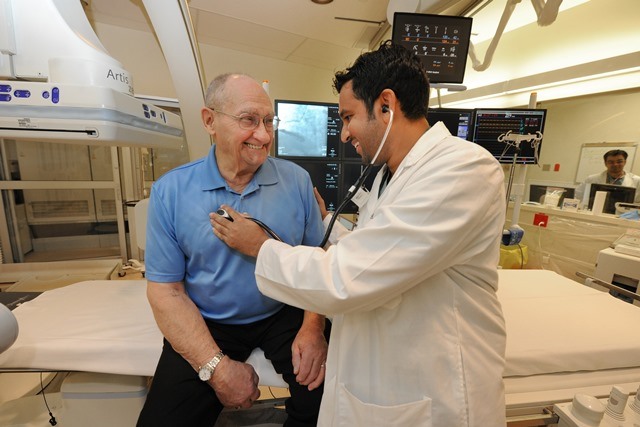In summing up his view on the value of research, heart-attack survivor Tom Lancaster doesn’t mince words: “If it weren’t for heart research, I wouldn’t be here right now.”
When he suffered a major heart attack last June, the 81-year-old Edmontonian soon found himself at the Mazankowski Alberta Heart Institute where he was diagnosed with a blocked artery and several narrowed vessels.
As he received treatment, Lancaster helped to reinforce the findings of a study led by the Mazankowski that’s answering one of the biggest questions about heart attack care which could lead to longer, healthier lives for survivors.
Typically, patients who suffer a major heart attack with a blocked heart artery are rushed to a catheterization laboratory for an angioplasty . Diagnostic imaging locates the clot, followed by the insertion, via catheter, of a balloon to widen the artery. Then a tiny wire-mesh tube, known as a stent, keeps the artery open.
Once blood flow is restored, cardiologists face questions that, at present, have no clear, evidence-based answers.
“Do we just leave other narrowed blood vessels and continue with medications? Or do we fix those narrowed vessels with other stents? What’s best for the patient?” says Dr. Kevin Bainey, an Alberta Health Services (AHS) interventional cardiologist who specializes in clearing blocked arteries, as well as an Assistant Professor of Cardiology at the University of Alberta.
Dr. Bainey and his cross-country research team systematically reviewed the outcomes of 46,234 patients around the world and their findings showed a two-stage treatment plan — in which the patient returns at a later date to clear up any other significant blockages — guarantees the best short- and long-term health and recovery for the patient.
Patients who underwent a staged angioplasty procedure plus medication had a 26 per cent reduction in long-term mortality compared to patients who received medication only, according to their study published in the January issue of American Heart Journal. Dr. Bainey is the lead author.
MORE: REMOTE CONTROL TREATMENT FOR IRREGULAR HEARTBEATS
Dr. Bainey’s analysis has now set the stage for a comprehensive international trial, which will involve the recruitment of 4,000 patients already underway. The Mazankowski is one of several participating sites in this Canadian-initiated, international trial.
Lancaster successfully experienced this two-stage approach to restoring his blood flow — and also chose to be part of the new study, as a way to pay it forward.
When the artery that was causing the heart attack was opened, Dr. Bainey determined Lancaster had another coronary artery with significant narrowing. Lancaster returned to the Mazankowski two weeks later, where Dr. Bainey put a stent in the second artery. Lancaster was discharged the following day and will be followed by the study for five years.
Adds Lancaster: “If it will help somebody down the road, that’s all that matters. And that’s why I signed up for this new research. It’s a major thing.”
MORE: CARDIAC DART PROVIDES CARE CLOSER TO THE DOOR
“I’ve already changed my practice, in being more aggressive with these other blockages,” says Dr. Bainey, who believes this new approach to restoring blood flow also holds the promise to reduce emergency department visits; free up hospital beds (as patients will be able to go home between procedures); and eliminate future hospital stays as patients live longer.
“My study shows patients who are ready to be discharged, but who need to have that other blockage fixed, don’t need to stay two to three days in hospital to wait for that blockage to be fixed. It’s safe to go home, then come back as an outpatient, have the procedure done, and be discharged later that day,” he says.
Nowadays, Lancaster hits the treadmill or exercise bike daily as he eagerly awaits spring thaw — and a new season of golf — so he can get back out on the links.
The Faculty of Medicine & Dentistry at the University of Alberta is one of the world’s top 100 medical schools where faculty members are committed to improving patient care through teaching and research.
Alberta Health Services is the provincial health authority responsible for planning and delivering health supports and services for more than four million adults and children living in Alberta. Its mission is to provide a patient-focused, quality health system that is accessible and sustainable for all Albertans.




